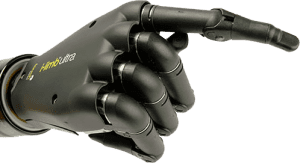New 3D Printed Prothetics Open Doors for Amputees and Patients with Congenital Defects.

News and media outlets are all a buzz these days sharing the positive personal stories of individuals with affected limbs that are benefiting from 3D printed prothetics. A new generation of prosthetic hand and arm designs are being provided through open source file sharing and distributed through creative social communities such as E-Nable.
E-Nable volunteers created a prosthetic hand for about $50 using 3D printed prosthetics and largely available hardware. Their goal is to help provide children and adults with low-cost 3D printed prosthetics and orthotic options previously not available.
What is 3D Printing?
3D printing, or “additive manufacturing”, has been around since the 1980s. This technology uses multiple layers of various materials to create a three-dimensional product from a 3D digital file. With commercial printer patents expiring, there is now an increase of relatively economical home printers for personal use and design. For those that need access to printers unavailable to them, there are large web-based printer communities that can print objects or designs and ship them directly to the individual. This approach is currently helping to keep printing costs low because it shares the equipment and material costs among a large group and typically uses a variety of plastics.
The current popular 3D printed prosthetics are for children and young adults with a congenital condition or amputation that results in a partial hand. The fingers are “powered” through the flexing of the wrist and use strings that act as muscles to close the fingers around the desired object. The color choices can be mild to wild depending on the image, imagination or the super hero that the person wants to portray.
While the overall strength of the fingers are limited, the imagination of the young wearer is released in a very powerful way with a new image to their peers and a spark of creativity that can provide a creative outlet for future designs and refinement.
The 3D Printed Prosthetics Are Not Limited to Just Upper Extremities Either.
Products now include custom printed prosthetic sockets, custom designed socket covers, and sculpted leg fairing covers by UNYQ. While the prosthetic covers have been available for a little while now, the prosthetic sockets designs are still in their infancy. Impact durability appears to be good for the sockets thus far; long-term use and wear issues are still being examined for long-term durability.
3D printed prosthetics is a rapidly emerging technology that will continue to evolve in designs, but even more so in material choices that will allow accelerated prosthetic integration.
With this new influx of designers dabbling in the prosthetic world with new materials, the world’s image of prosthetics is about to enter a new chapter of bio-engineering, sculpting, and image thanks to 3D printed prosthetics.
POSI is eager to embrace the appropriate technologies that can improve the lives of our patients. Not all options are appropriate for everybody as there are usually limitations, but we are open to an honest discussion of how to best restore lost function and desired lifestyle.


